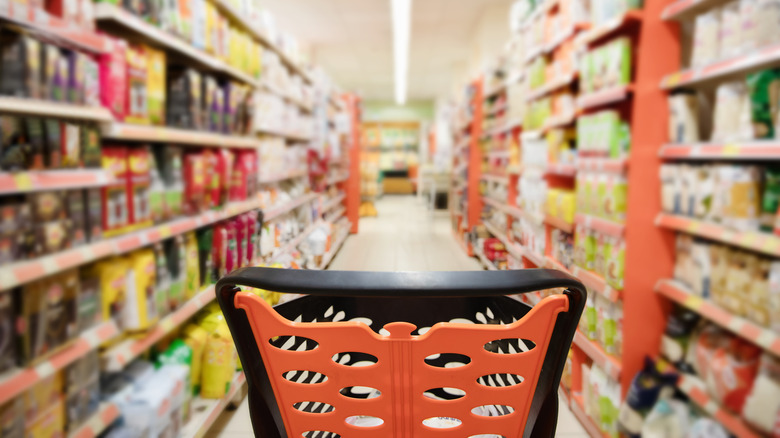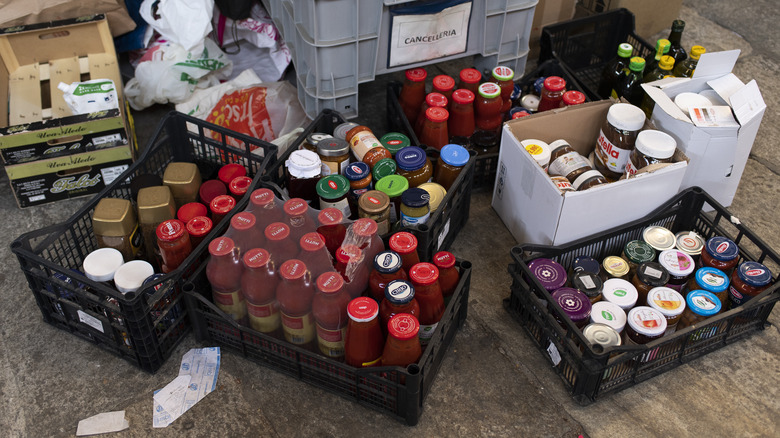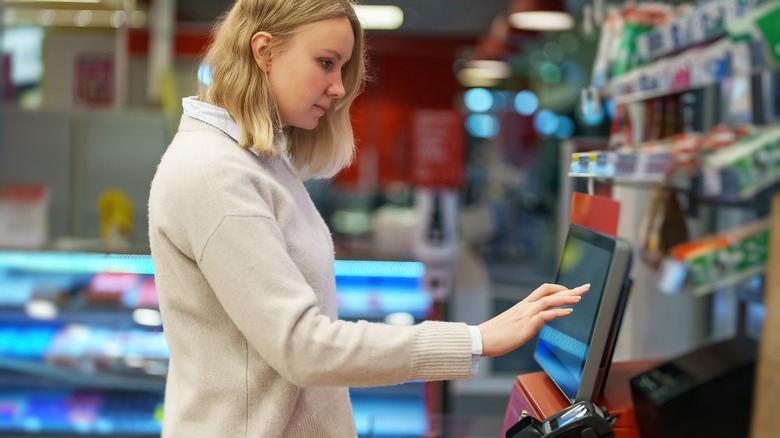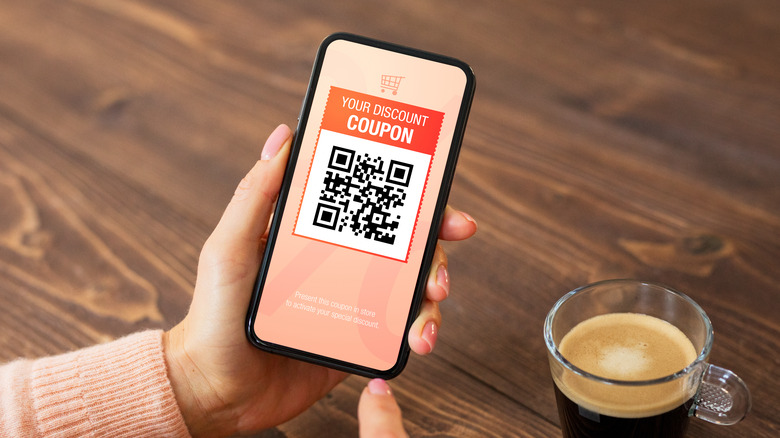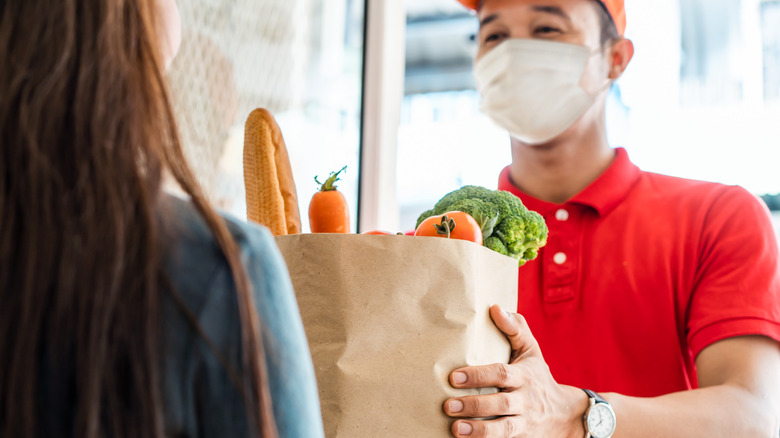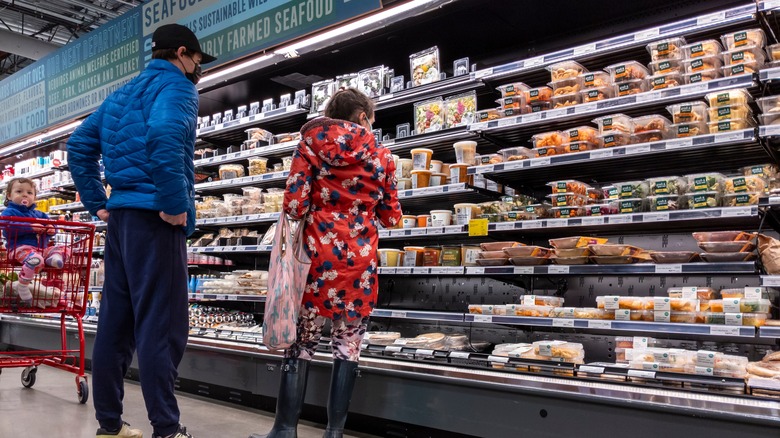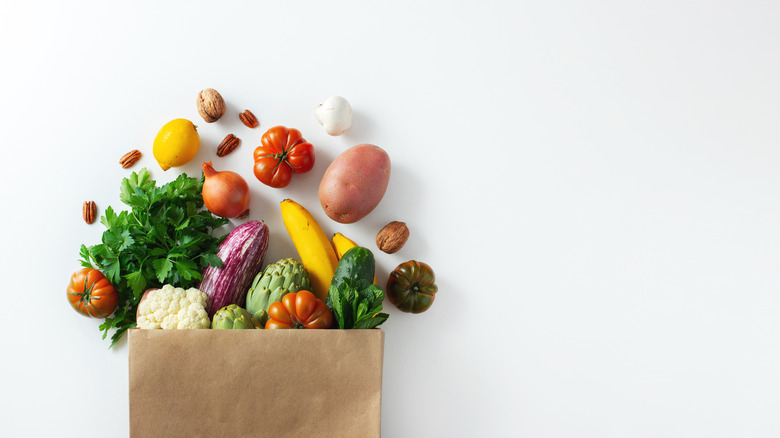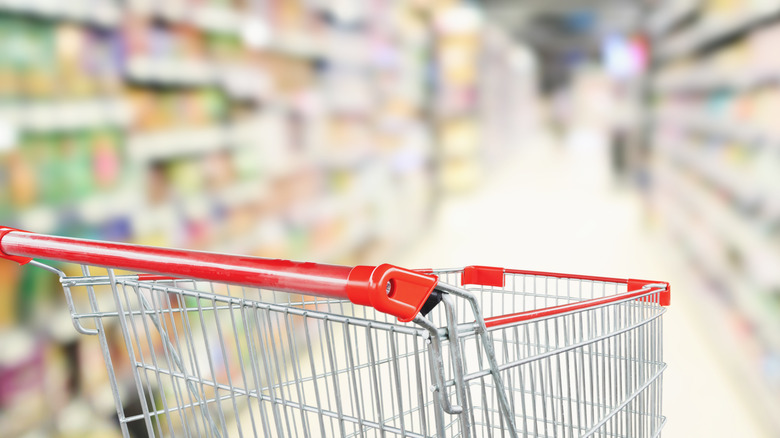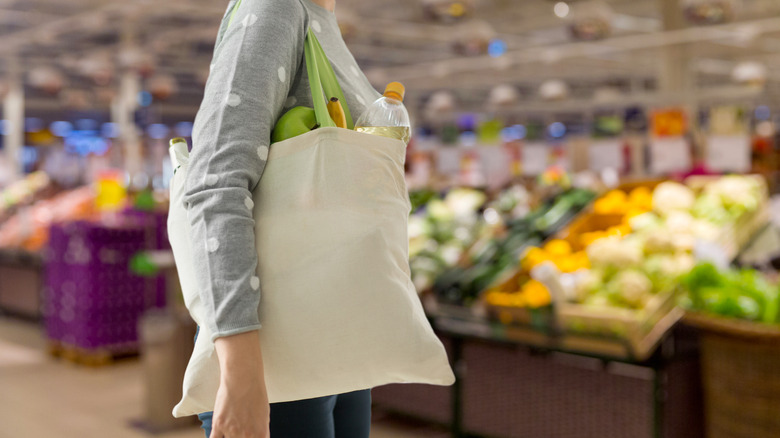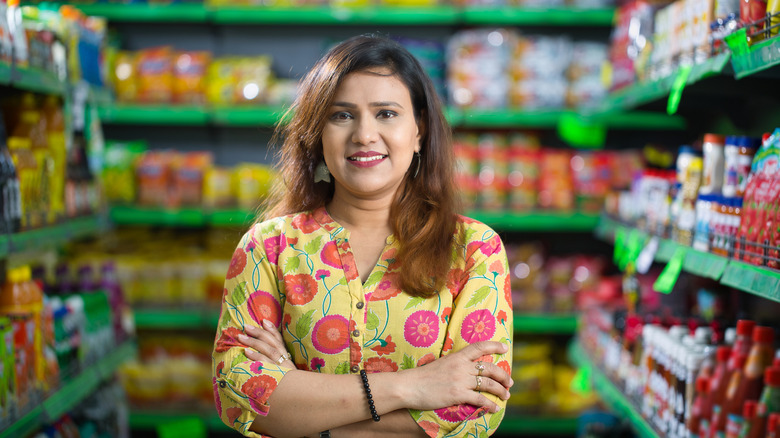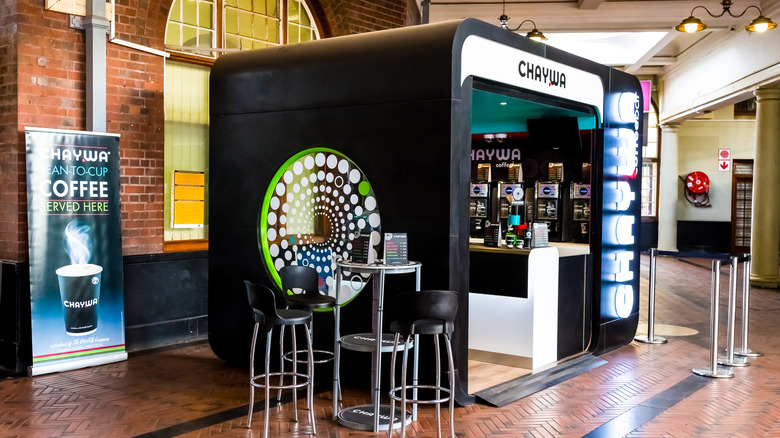How Shopping For Groceries May Change In The Future
Shopping for groceries has changed a lot since Vincent Astor, son of business tycoon John Jacob Astor IV, opened the Astor Market in New York's Upper West Side in 1915. Vincent Astor had the then-revolutionary idea of selling all one's daily provisions — meat, produce, and dry goods — under one roof. This innovation offered not only convenience, but more importantly for New Yorkers slammed by high food prices in the wake of World War I, savings. It sounded like a winning formula — but unfortunately for him, Vincent Astor was ahead of his time. Shoppers trusted and liked their independent butchers and greengrocers and avoided the Astor Market in droves, despite the glowing press it received. The store only survived until 1917.
But it didn't take long for Astor's vision to be vindicated. In 1916, even as the Astor Market was struggling to stay afloat, the first self-service supermarket chain, Piggly Wiggly, opened its doors. And today, the idea of going to four different shops for meat, milk, vegetables, and soap is nearly unthinkable for most Americans. Supermarkets are continuing to evolve, with many big (and likely permanent) changes triggered by the COVID-19 pandemic, according to The New York Times. You've probably seen some of these changes already – and here are more you can expect to see in the months and years to come.
Store brands will continue to become more popular
It wasn't that long ago that major brand-name items were seen as the default choices, and store brands were considered sorry compromises, if considered at all. No self-respecting party host would think of serving guests store-brand cola instead of Coke, or no-name crackers instead of Ritz. And many a traumatized adult remembers the grade-school shame of a penny-pinching parent serving these no-name snacks to their friends. The mortification was real.
But with the onset of COVID-19 and supply chain challenges that made some popular brands hard to obtain, consumers started giving store brands a second look. And once they tried them, they stuck with them — and for good reason: As noted by Marketplace, the quality of store-brand products has improved, lifting much of their previous stigma. "Private labels always gain when people are forced to try them and then update their belief system, which makes them stick to them," Katrijn Gielens, a marketing professor at the University of North Carolina, told Marketplace.
Expect to see fewer checkers and more automation
During the pandemic, supermarket staffers were considered "essential workers." But faced with cranky customers and a higher-than-average risk of contracting a potentially deadly disease, many left the industry for less-stressful opportunities elsewhere, and supermarkets found themselves hard-pressed to find replacements. This didn't stop shoppers from coming, so supermarkets turned to automation.
What does this mean for shoppers? Many will see more self-checkout kiosks and fewer human checkers, according to Grocery Dive. Other innovations taking hold include electronic shelf labels (ESLs), which are basically digital versions of the paper price labels on each shelf. With ESLs, a single person can instantly change prices and monitor inventory throughout the store from a computer terminal, saving significant labor hours, according to Winsight Grocery Business. ESLs are already in widespread use in Europe, and according to Winsight Grocery Business, Kroger is developing its own proprietary ESL system. But while stores won't need as many people to manage shelf labels and checkout, real humans will still need to be there to stock the shelves and handle problems and questions. So you will still see some familiar faces at your favorite market in the years to come.
We may see more online shopping options
Online grocery shopping exploded during the pandemic when cautious and time-pressed shoppers took advantage of the convenience and safety of contact-free delivery or curbside pickup. And while the threat of COVID is no longer as severe, and many consumers report that they enjoy the experience of in-person browsing and shopping, online ordering is here to stay, according to Supermarket News. Consumers enjoy the convenience of ordering and paying for their groceries online, and for this reason, online grocery shopping is projected to continue growing in popularity: A study by Mercatus projects that the percentage of grocery sales conducted online will grow from 11% in 2022 to 20.5% in 2026.
Online shopping seems to appeal to shoppers on the move — Supermarket News reports that three times as many online shoppers plan to shop using mobile devices than on desktop computers in the coming two years. This may prove to be a boon to supermarkets since shoppers using mobile apps looked at 4.2 times more products.
You'll get more personalized offers
You may remember your parents or grandparents carefully clipping grocery store coupons from the daily newspaper and tucking them into their wallets (or kitchen drawers) in pursuit of serious savings. Until recently, everyone got the same deals, period, and if you weren't interested in what was on offer, well, you didn't have to buy it. And even now, many grocery stores still offer coupons and specials everyone can take advantage of — and these remain popular.
But you may have started noticing something else too. If you buy a pint of Ben and Jerry's every week from your favorite supermarket, perhaps you've found a coupon for discounted Ben and Jerry's at the bottom of your receipt. Or perhaps you've received an email or shopping app coupon for another premium ice-cream brand. This is not a coincidence: Supermarkets are taking advantage of new data-gathering tools to offer personalized shopping experiences for their customers, according to Winsight Grocery Business, and strategies using these tools will offer shoppers increasingly personally targeted promotions in the future. So yes, your supermarket knows all about your sweet tooth — and will be ready with more treats the next time you visit.
Faster delivery will become the norm
During the pandemic, grocery delivery services were not only a welcome convenience but a godsend to many families. Shoppers loved the convenience of ordering and paying for groceries from home, and they loved being able to get everything they needed without leaving home even more. But as the world opened up again, even shoppers who appreciate the convenience of online shopping now largely opt to pick up their groceries in person. According to Supermarket News, the percentage of online shoppers opting for home delivery dropped from 31% at the height of the pandemic to 24% in 2022.
Still, home delivery hasn't gone away, nor will it any time soon. Instead, to win new customers and make their services more attractive to doubters, grocery delivery services are focusing on speed. As Forbes notes, half of all consumers would switch to a competitor offering faster delivery times, and long lag times and late deliveries are significant complaints among users of grocery delivery services. To address these concerns, Instacart is partnering with grocery chain Publix to offer 15-minute deliveries in Atlanta and Miami — and a number of startup competitors are fast on their heels.
You'll have more and fresher prepared food options
We all love freshly cooked meals prepared with high-quality ingredients. But not all of us have the time or skill to cook them. Fortunately, gone are the days when a lazy cook's only options were ponying up for a restaurant meal, settling for a delivery pizza, or picking up a frozen entrée or rotisserie chicken from the supermarket. As consumers' palates grew more refined and their expectations grew higher, supermarkets realized they needed to up their game and have started offering ready-to-eat options that don't feel (or taste) like compromises.
To meet these demands, grocers are exploring new partnerships to offer more appealing prepared meal options to their shoppers. As Grocery Dive reports, select Kroger's locations will have their own onsite kitchens to prepare and serve meals from popular restaurant chains. Diners will have the option of enjoying their meals at the store or ordering meals to take home. And even discount chain Wal-Mart is getting in on the gourmet meal trend: The chain is now offering meal kits by Blue Apron through its online ordering system. Shoppers will be able to choose between Blue Apron's standard quick-prep recipe boxes and ready-to-eat meals.
Expect a bigger range of premium products
At the height of the pandemic, going out for a restaurant meal or a drink at a local gastropub wasn't an option. So to make their at-home eating experience more interesting, consumers began opting for more premium products, such as gourmet pasta sauces, wine and liquor, and high-end chocolates, according to CNBC. Consumers weren't necessarily spending more money on food than before — they were just spending their money differently. And as consulting firm IRI noted, the urge to splurge transcended income levels — even low-income consumers saw the occasional high-end chocolate bar as an affordable luxury.
And while restaurants and bars have reopened, consumer demand for premium products continues to grow, so expect to see a bigger range of new premium products on the shelves of your local supermarket. Also, you won't just be seeing fancy new options among your food choices. According to IRI, markets for natural and premium hair care and personal care products have also been seeing significant growth.
You'll also see a bigger choice of healthful options
No one ever said human beings were logical and consistent. While grocery shoppers in recent years have enjoyed splurging on premium ice cream and chocolate, they've also become increasingly interested in healthier food options and healthier lifestyles, according to Forbes. Supermarkets are starting to employ a number of strategies to cater to this interest, from shelf tag icons identifying products as gluten-free, keto, and more, to offering dietitian tips, weekly meal plans, and recommendations for "better for you" alternatives. This interest in healthy eating is also reflected in the explosive growth of plant-based foods. According to the Plant-Based Foods Association, sales grew three times faster than total retail food sales in 2020.
And while your favorite supermarket will continue to stock plenty of Twinkies and doughnuts, you might soon see subtle suggestions to choose your food wisely. As Forbes notes, supermarkets are starting to experiment with strategies to encourage healthful food choices, such as express checkout lines for healthful products, more prominent placement for low-sugar cereal options, and free fruit — not cookies — for kids.
You'll get much more than groceries at your local supermarket
If you think all your local supermarket can offer you are basic provisions and the occasional deli sandwich or rotisserie chicken, think again. Already, supermarkets such as Wal-Mart are offering walk-in clinics and labs, financial services, and more — so you can get your cholesterol checked, buy insurance, and get your taxes prepared all while stocking up on vegetables and cat food. And other large supermarkets are following their lead. According to McKinsey, supermarkets such as Wal-Mart are coming to recognize that their heavy foot traffic, loyal customer base, and brand familiarity can offer advantages to other businesses looking to attract new customers — and building partnerships with other consumer service providers offers a win-win situation for everyone involved.
In the months and years to come, you may also see products on the shelves you wouldn't expect to see in a major supermarket — such as handmade local products and small local brands. This doesn't mean their makers suddenly nabbed a nationwide distribution deal. Instead, as McKinsey reports, they're taking advantage of lesser-known services some supermarkets have started offering to other businesses — a marketplace (analogous to Amazon's marketplace) that lets small manufacturers use the supermarket's fulfillment services to get their products in front of new customers. In short, supermarkets are finding new ways to monetize their resources — and shoppers are getting new options and shopping experiences.
Store layouts will see big changes
Anyone who's been shopping at the same supermarket for a while will notice that items get shifted around from time to time — one week, the canned soup aisle will be by the produce section, the next, it may gravitate to some other part of the store. But as Grocery Dive notes, bigger, more fundamental changes to supermarket layouts are starting to emerge, and your regular grocery visits may soon look very different.
A big reason for these changes is the rise of online ordering. Shoppers who adopted online shopping out of necessity during the pandemic are continuing to embrace it for its convenience. And the trend toward online grocery shopping is projected to keep growing, according to Supermarket News. But as Supermarket News notes, online shoppers are turning away from the extra expense of home delivery and opting for curbside and in-store pickup. This means supermarkets will need to dedicate more floor space (including refrigerated lockers) to awaiting online orders, as well as extra accommodations in the parking area for curbside pickup. This doesn't mean, however, that your local supermarket will become nothing more than a grocery pick-up depot. Supermarkets are also looking to create more engaging in-store experiences to encourage lingering and additional shopping, such as food courts offering hot meals to go and attractive displays of fresh foods, according to Grocery Dive.
Your local grocery store may get smaller
For many supermarket chains, bigger isn't always better. Aiming to control costs and increase profits, grocery chains are experimenting with smaller-format stores with more targeted product inventories. As noted by Progressive Grocer, retail footprints have been growing smaller for over a decade, and as Grocery Dive notes, smaller stores are not only less expensive to operate, but easier to fit into dense urban areas or isolated rural areas that can't accommodate traditional large grocery stores.
As one would expect, these smaller stores won't have the same wide-ranging inventory as their bigger counterparts. Instead, they will offer more carefully curated inventories while striving to provide an engaging customer experience. For instance, the supermarket chain Sprouts Farmers Market plans to open four small-format stores that will offer customers a "treasure hunt experience," according to Grocery Dive. Additionally, Shmuck Markets plans to open a small-format store, Shmucks Fresh, that will focus on fresh foods and meals.
Stores within stores will become more common
Another change you may expect to see in the coming years are stores within stores — so if you walk into your local supermarket, don't be surprised to see a freestanding kiosk or section dedicated to a bank, pharmacy, or another specialty retailer. As Chain Store Age reports, despite their recent pivot towards online shopping, supermarkets still want to bring foot traffic into their stores, and partnering with other businesses (who pay a share of their revenue to the supermarket) has proven an effective way to offer customers new shopping experiences while monetizing previously underutilized space.
Chain Store Age notes these stores within stores can be attractive to shoppers for a number of reasons. Banks and clinics can offer shoppers the purely practical advantage of one-stop shopping: Why drive to the supermarket, then the bank, when you can go to a supermarket that has both? But stores within stores can also make the grocery shopping experience more fun and memorable: Pop-up shops — which may stick around for a few months before being replaced — offer shoppers novel experiences as well as novel products. "Pop ups go way beyond transactional retail experiences, which is what stores have offered for the longest time," Ana Pelucarte, CEO of Pop Up Mob, told Parterre.
